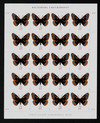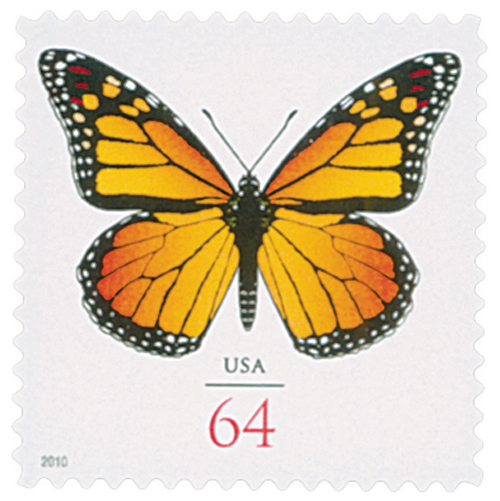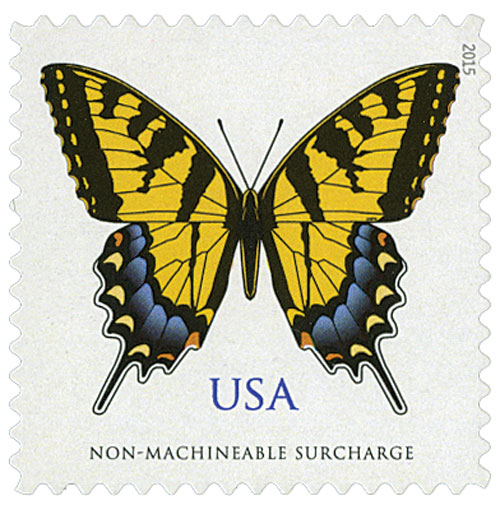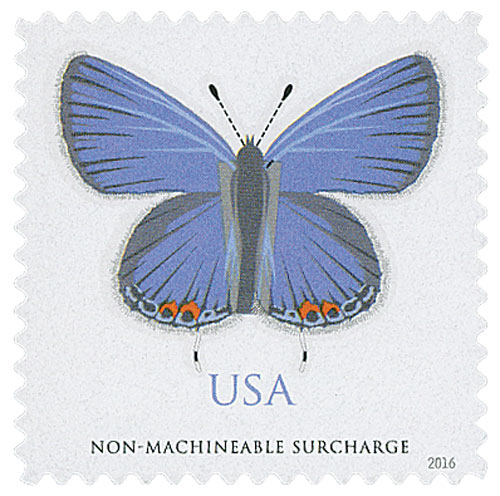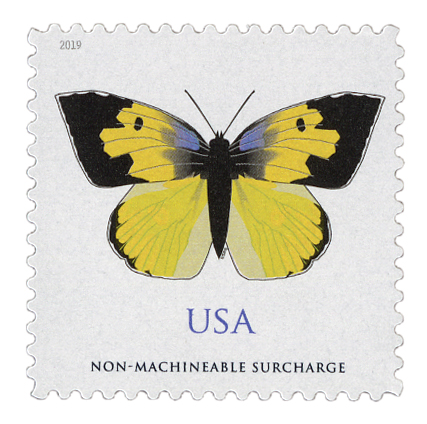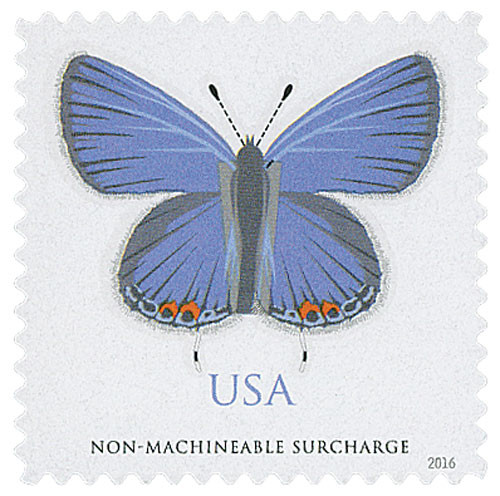
# 4603 - 2012 65c Baltimore Checkerspot Butterfly
U.S. #4603
2012 65¢ Baltimore Checkerspot Butterfly
Issue Date: January 20, 2012
City: Baltimore, MD
Quantity: 15,000,000
Printed By: Avery Dennison
Printing Method: Photogravure
Perforations: Die Cut 10 ¾
Color: Multicolored
This is the second butterfly stamp issued for use on large greeting card envelopes that require additional postage.
The Baltimore Checkerspot butterfly was made the Maryland state insect in 1973 because of its abundance. However, fewer Checkerspots in recent decades resulted in their threatened status.
Because of its black and orange design, the Baltimore Checkerspot was named after Sir George Calvert, the first Baron Baltimore. His family crest has the same colors, which also appear on the state flag.
Baltimore Checkerspots usually lay their eggs on the underside of the leaves of the turtlehead plant, a member of the snapdragon family. A lack of these plants is one reason for the Checkerspot’s decline.
The white-tailed deer population has been increasing. These deer have been eating the turtlehead plants, and along with them, the Checkerspot’s nurseries and young larvae. Other reasons there are fewer Checkerspots include habitat loss to both development and agriculture, plus insecticide drift from nearby crops.
Different groups in the state have been taking measures to help save the Checkerspot. These include setting aside a small area of wetland and installing a deer-exclusion fence. Others have been breeding the butterfly in captivity or searching for existing colonies to protect. According to one of these conservationists, “I don’t think there’s anything more important.”
Butterfly Series
In late 2009, the USPS unveiled the first butterfly stamp for greeting card envelopes that required additional postage (an extra 20¢) than the standard one-ounce rate covered. This would apply to envelopes that couldn’t be sorted on the USPS’s automated equipment, otherwise known as “nonmachinable.”
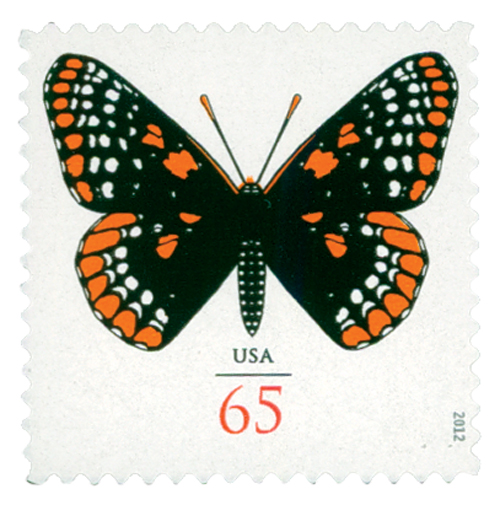
Some of these nonmachinable envelopes include those that are oddly-shaped or vertical, lumpy, rigid, or with clasps, ribbons, or buttons on them. Even if an envelope weighed less than one ounce, but was unmachinable, it would need this stamp. However, letters that were simply heavy didn’t necessarily need it. The two-ounce rate at the time was 61¢, and this stamp was 64¢, so they would be overpaying by 3¢ if they used it.
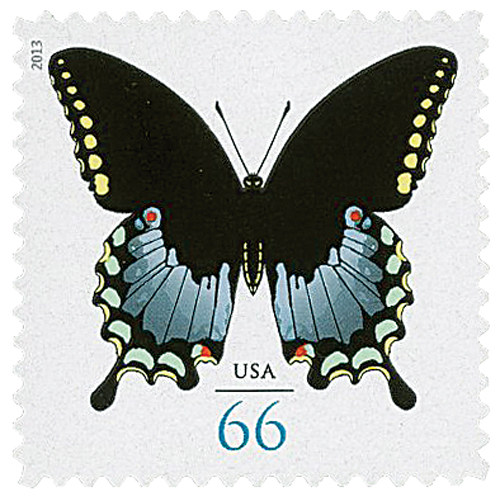
The USPS worked closely with the greeting card industry on this new stamp. Prior to this issue, some greeting card envelopes would be imprinted with “extra postage required.” With the creation of this new stamp, the Greeting Card Association encouraged its members to print a butterfly silhouette on the envelopes of cards that would require this additional postage. Reflecting this close working relationship, the 64¢ monarch butterfly stamp was issued on May 17, 2010, at the National Stationery Show held at the Jacob Javits Center in New York.
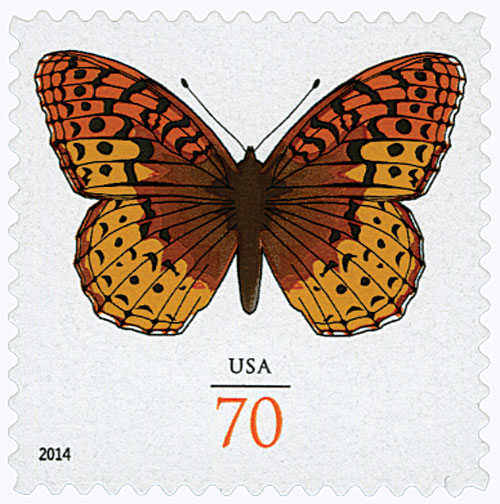
The monarch stamp remained in use for two years, being replaced by the Baltimore checkerspot butterfly stamp in 2012 when the nonmachinable rate increased to 65¢. New stamps were issued each year through 2016. The 2015 and 2016 followed the Forever format, in printing “non-machinable surcharge” on the stamp, rather than the actual denomination.
The California dogface butterfly stamp was initially announced in 2016 and expected for a 2017 release. However, the USPS said that they had designed the stamp, but wouldn’t produce it until supplies of existing butterfly stamps were nearly depleted. So that stamp wasn’t issued until 2019.
Click here to view lots more US and worldwide butterfly stamps.
U.S. #4603
2012 65¢ Baltimore Checkerspot Butterfly
Issue Date: January 20, 2012
City: Baltimore, MD
Quantity: 15,000,000
Printed By: Avery Dennison
Printing Method: Photogravure
Perforations: Die Cut 10 ¾
Color: Multicolored
This is the second butterfly stamp issued for use on large greeting card envelopes that require additional postage.
The Baltimore Checkerspot butterfly was made the Maryland state insect in 1973 because of its abundance. However, fewer Checkerspots in recent decades resulted in their threatened status.
Because of its black and orange design, the Baltimore Checkerspot was named after Sir George Calvert, the first Baron Baltimore. His family crest has the same colors, which also appear on the state flag.
Baltimore Checkerspots usually lay their eggs on the underside of the leaves of the turtlehead plant, a member of the snapdragon family. A lack of these plants is one reason for the Checkerspot’s decline.
The white-tailed deer population has been increasing. These deer have been eating the turtlehead plants, and along with them, the Checkerspot’s nurseries and young larvae. Other reasons there are fewer Checkerspots include habitat loss to both development and agriculture, plus insecticide drift from nearby crops.
Different groups in the state have been taking measures to help save the Checkerspot. These include setting aside a small area of wetland and installing a deer-exclusion fence. Others have been breeding the butterfly in captivity or searching for existing colonies to protect. According to one of these conservationists, “I don’t think there’s anything more important.”
Butterfly Series
In late 2009, the USPS unveiled the first butterfly stamp for greeting card envelopes that required additional postage (an extra 20¢) than the standard one-ounce rate covered. This would apply to envelopes that couldn’t be sorted on the USPS’s automated equipment, otherwise known as “nonmachinable.”

Some of these nonmachinable envelopes include those that are oddly-shaped or vertical, lumpy, rigid, or with clasps, ribbons, or buttons on them. Even if an envelope weighed less than one ounce, but was unmachinable, it would need this stamp. However, letters that were simply heavy didn’t necessarily need it. The two-ounce rate at the time was 61¢, and this stamp was 64¢, so they would be overpaying by 3¢ if they used it.

The USPS worked closely with the greeting card industry on this new stamp. Prior to this issue, some greeting card envelopes would be imprinted with “extra postage required.” With the creation of this new stamp, the Greeting Card Association encouraged its members to print a butterfly silhouette on the envelopes of cards that would require this additional postage. Reflecting this close working relationship, the 64¢ monarch butterfly stamp was issued on May 17, 2010, at the National Stationery Show held at the Jacob Javits Center in New York.

The monarch stamp remained in use for two years, being replaced by the Baltimore checkerspot butterfly stamp in 2012 when the nonmachinable rate increased to 65¢. New stamps were issued each year through 2016. The 2015 and 2016 followed the Forever format, in printing “non-machinable surcharge” on the stamp, rather than the actual denomination.
The California dogface butterfly stamp was initially announced in 2016 and expected for a 2017 release. However, the USPS said that they had designed the stamp, but wouldn’t produce it until supplies of existing butterfly stamps were nearly depleted. So that stamp wasn’t issued until 2019.
Click here to view lots more US and worldwide butterfly stamps.








